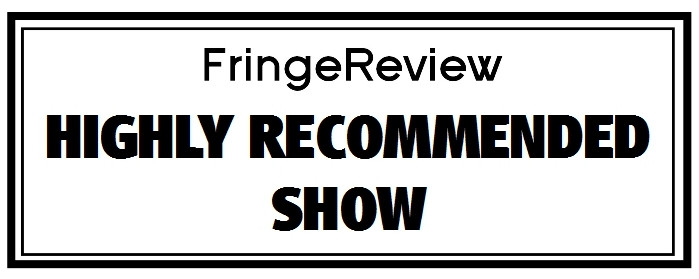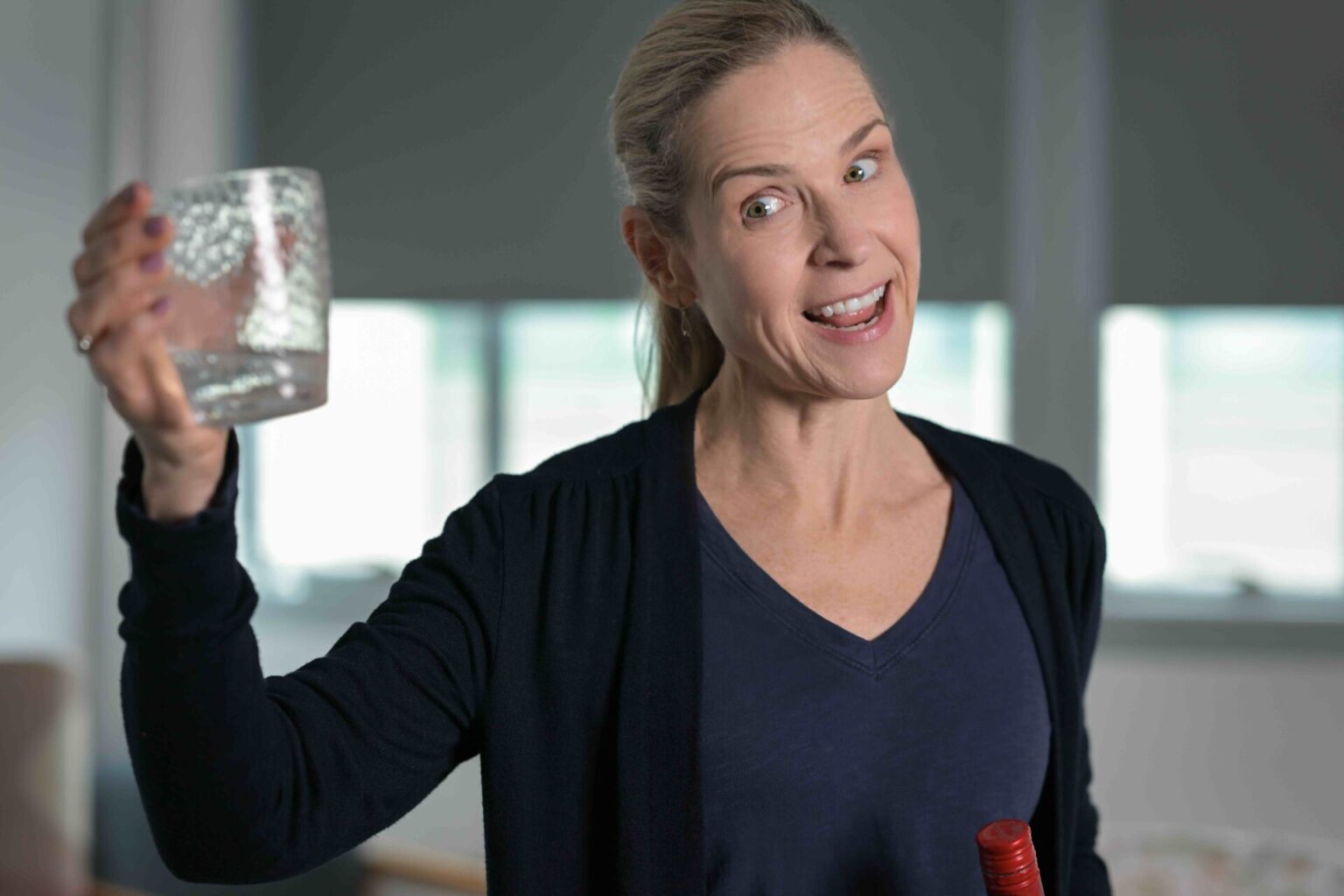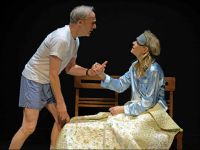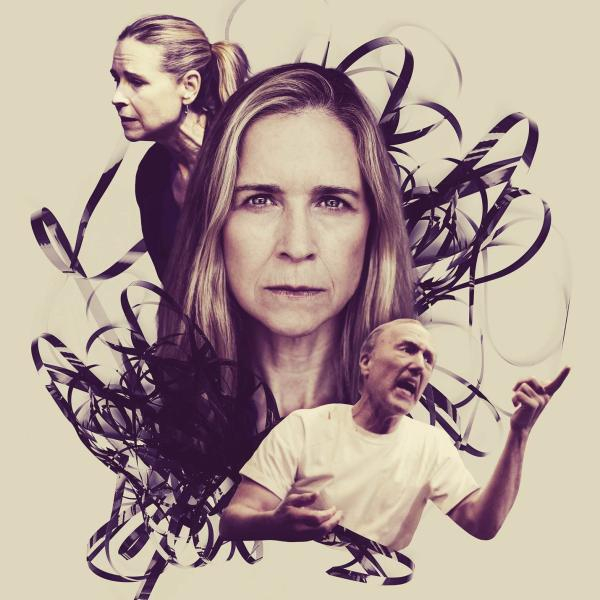FringeReview UK 2025
The Space In-Between
Margaret Curry, Deep Flight Productions

Genre: Music, Story Songs
Venue: The Crazy Coqs at Brasserie Zédel, London
Festival: FringeReview UK
Low Down
Margaret told us stories in songs and in tales from her life, her family: ‘the spaces in-between is where the magic happens’. She is a charming powerhouse and completely in control of her material. We saw an actress doing what she does best, using music, words and her craft to make us understand how she and we feel about the world.
Review
I had the privilege to review Margaret Curry’s performance at the Edinburgh Fringe in August this year, where she gave a master-class in acting in the one woman play ‘Who We Become Part 1: The Moonshot Tape’ by Lanford Wilson. I was thus keen to see what else she would do and went with a friend to London to hear Margaret sing at this one-off concert, her London debut. A few words about the venue: The Brasserie Zédel is a real find near Piccadilly Circus, a French themed venue with a café, an American bar, an enormous glittering and noisy restaurant and a small and intimate club, the Crazy Coqs, where this concert began at 9.15pm with a small but enthusiastic crowd attending. They had interesting cocktails for sale and the snacks were tasty, the portions generous. A lovely ambience, we decided that just coming here was already worth the journey.
Three musicians sat down on stage: the drummer, a solid David Silliman, struck up a pacy rhythm and in strode Margaret Curry – beautiful in a long black gown that showed off her toned arms, her hair golden and wavy – and began to scat-sing ‘Day In, Day Out’ (Mercer/Bloom) to a bare beat and with an energy that made me wonder how she was going to keep that up for the next 75 minutes (she did!). Soon Gregory Toroian, beautifully relaxed and creative on the piano and Skip Ward, confident on the bass, joined in and we were off on an adventure in songs that without any exception had lyrics worth hearing, if perhaps only this time. Margaret is an actor and she pays real attention to the words before she speaks or sings them. The line I feel sums up the evening best comes from Elvis and Me by Jimmy Webb, an almost corny ditty about a fan who meets his hero: “Let me tell you a story”.
Margaret told us story after story, in songs and in tales from her life, her family: ‘the spaces in-between is where the magic happens’ is how she explained the title of her show. It was hard for me to forget the Margaret I saw in Edinburgh, the grim, devastatingly hurt woman she played there against this smiling powerhouse, charming and completely in control of her material, her wonderful stories. I kept expecting her to crash, to tell us something dreadful, but that was then, this was a different show; still, again we saw an actress doing what she does best, using music, words and her craft to make us understand how she and we feel about the world.
Some very well known songs were almost forensically examined, for example ‘Ain’t nobody loves me better’ (David “Hawk” Wolinski) made famous by Chaka Khan, becomes the most beautiful and urgent love story when sung by Margaret Curry. The first lines “Captured effortlessly/That’s the way it was” are tempting to say out loud and even though the rest of the lyrics are almost trite when sung in the original version, we saw and felt now that this woman was deeply in love with a man, it was as if he was standing there in front of her, and she meant every word and made them suddenly sound not at all trite.
Many of the songs were linked to Margaret’s family story. She told us how she left Houston “Oh black water, keep on rolling” and went to New York City for, as she said, “creativity and joy to be her North Star”. She later visits Texas again in song, hysterically sending up the ladies who bring shared lunches with outrageous ingredients in the “Lime Jell-O Marshmallow Cottage Cheese Surprise” (William Bolcom). This and other songs showed off her ability to speed through patter like a demon without one word missing – her delivery crystal clear. And I shall never forget the little compressed laugh with which she characterised the main lady.
There were tender and emotional moments when Margaret described how her parents coped with dad having to care for mum after 50 years of marriage and quoted the song ‘There may be trouble ahead’ singing the sad and prescient line: “Soon, we’ll be without the moon” as part of the storytelling.
My friend and I loved it when Margaret sang with her full voice, giving us ballads about women and their fates, reminding us how far we have come, touchingly telling the tale of ‘The Ballad of Robin & Marian’ by Michele Brourman, and the angry and quite shocking ‘The Last Words of Bonnie Parker’ by Susan Werner, two female singer/songwriters I am excited to discover.
I would have wished for Margaret to have had a sympathetic hand at the sound engineering desk, someone who knew her and the songs well enough to softly support her on some of the more exposed notes with gentle reverb. After three weeks performing two very demanding plays at the Fringe, her voice could perhaps have done with a break before embarking on such a full on programme of songs. My friend and I were both a bit annoyed at the incidental music that played before and immediately after the concert, it sounded flat, was in keeping neither with the concert nor the venue, and gave us no chance to even clap for an encore. While everything there was beautiful and lovingly styled, the technician in his shorts and t-shirt looked like he had ambled in off the street and was not part of the event. But that is a tiny concern, it was a brilliant evening and we were both thrilled to have been there.
 'Margaret Curry in Lanford Wilson's Who We Become: Incredible'
'Margaret Curry in Lanford Wilson's Who We Become: Incredible'
The Moonshot Tape (Part One of Who We Become)
Shoot for the Moon.
★★★★★
The Recs RDC - By: Randall David Cook
Fortunately theatrical fireworks explode when Diane, the successful short-story writer in The Moonshot Tape (the first part of Who We Become, a trilogy of rarely staged one-act plays by Lanford Wilson) returns to her hometown in Missouri to clean out her childhood home now that her mother has been moved to a nursing facility. A student journalist from Diane’s high school alma mater has come to interview her, and in so doing dredges up memories that Diane had heretofore kept private. As staged, the audience becomes that journalist, absorbing everything Diane has to say about writing, and nothing is out of bounds: “Do whatever it takes.”

Diane drinks freely and continuously during the interview, saying “You’ve caught me at a low ebb.” As glass after glass gets drained and refilled, Diane gets more detailed and direct with her responses. She’s not happy to be home, but she does want to set the record straight, and accurately, even if it reveals parts of herself that would be better off kept private. “Never underestimate the power and excitement of revenge,” she says, and more than once. Diane has been able to capitalize on the miseries of her childhood via her writing, but she carries no illusions that the writing has actually saved her in any way other than financial.
Wilson was a great American playwright who isn’t as well-known across the pond as he should be, but here he is done great, honorable service by Margaret Curry, who gives a phenomenal, transfixing performance as Diane. Curry perfectly straddles the line between simmering anger and the kind of cathartic euphoria that comes only when darkness meets the truth of light. So powerful is Diane’s monologue that the audience exhales at the end of her interview with relief even though it is now unwittingly implicated and involved.
© The Recs RDC - By: Randall David Cook
The review Hub - Edinburgh Fringe 2025: Who We Become – theSpace@Surgeon’s Hall, Edinburgh
Writer: Lanford Wilson / Director: Mark Cirnigliaro
As it’s relatively rare to find straightforward productions of established plays at the Fringe, this offering from New York-based Deep Flight Productions stands out from the pack. It’s actually two shows being performed on alternate days, but both feature one-act plays by Pulitzer Prize winner Lanford Wilson (1937–2011).
In The Moonshot Tape, a successful writer (Margaret Curry) visits the small town where she grew up and fields questions from a list handed to her by a high school student. This becomes a self-interview, lubricated by copious quantities of booze, which rapidly descends into a bleak rumination on the past. It’s sophisticated, funny, tragic.
Curry’s acting is so off-the-scale excellent I would recommend any of the Fringe’s up-and-coming theatre performers to check it out. She inhabits the role with complete conviction and delivers the lines as if they’ve never been said before, let alone written down. This is indeed a masterclass in collapsing the gaps that can exist between performer and role, between lines and delivery. It’s nothing short of sensational.
The second show opens with Breakfast At The Track, a vignette in which Curry gives another delicious turn alongside Geoff Stoner, as a couple with very different bio-rhythms. Stoner then gives a superb performance of the AIDS-themed play A Poster Of The Cosmos. It’s an absolute privilege to see these now rarely-performed plays being given such an impressive revival, conveniently served up in bite-size chunks.
Due to the ‘mature and intense’ themes addressed in both shows, there is a content warning on the programme for Who We Become. Do check this before watching and note that this content is not suitable for children.
Fringe 2025: Who We Become Part 1 and 2

Rating: ★★★★★
 Part 1 of the Pulitzer Prize winning Who We Become follows the interviewing of an inspiring writer and her brutally honest insights as she dissects her relationship to her small town, her family, her childhood, and the relationship of these factors to her writing. The performance glows with the subtlety of the details; Margaret Curry’s body language becomes increasingly more erratic as she moves around the stage with alcohol in her hand, her dialogue increasing in mania, distress rises steadily throughout her monologue.
Part 1 of the Pulitzer Prize winning Who We Become follows the interviewing of an inspiring writer and her brutally honest insights as she dissects her relationship to her small town, her family, her childhood, and the relationship of these factors to her writing. The performance glows with the subtlety of the details; Margaret Curry’s body language becomes increasingly more erratic as she moves around the stage with alcohol in her hand, her dialogue increasing in mania, distress rises steadily throughout her monologue.
The effect of the interview structure allows for the audience to subconsciously analyse their own position as a body unable to interfere; placed in a position that commonly responds, we are aware of our position as a silent observer and all the more surrendered to the performance of the actors.
The difficulty of the subject matter further allows for an audience to be acutely aware of their position as unable to move from the unflinchingly honest narrative. It was certainly a surprise to be faced with highly difficult subject matter with very little warning, and it’s difficult to say whether the performance requires a stronger content warning. Yet it is undeniable the way it adds to the show’s effectiveness; the story is dark and gritty, making it all the more profound.
Part 2 in a similar way focuses on the complexity of the characters being placed in front of us. It continues Part 1 with its tragic themes and similarly superb acting. Rather than shying away from the tough subject matter, Curry speaks of it head- on, forcing a deliberate sense of deep discomfort in the audience. The boldness of her performance stands out easily as the highlight of the show, unable to be described in any other way than remarkable.
After the performance, albeit packing a sharp emotional punch that renders almost unable to process their surroundings following, a friend leaned in and asked: “So what’s Part 2?” The two part structure of the play is unique within the Fringe, forcing audiences to return to the same place and allowing them once again to question their position as an audience.
Rather than positing two separate performances, Who We Become chooses to keep these two one-act sagas connected. In this way, it continues to be most effective in the control it holds over its audience, whilst giving them a unique sense of independence in choosing to form their own connections between the individual characters and their stories.
Who We Become Part 1 has its final show on 22 August, and Who We Become Part 2 has its final show on 23 August, both at Haldane Theatre at theSpace at Surgeons’ Hall.
© thestudentnews.co.uk - By:
'Curry’s acting is off-the-scale excellent'
'a masterclass... it's nothing short of sensational'
'Stoner gives a superb performance'
'It’s an absolute privilege to see these rarely-performed plays being given such an impressive revival'
 An interview with Margaret Curry, part of the cast in, WHO WE BECOME PARTS 1 & 2 ahead of the Edinburgh Fringe opening this week.
An interview with Margaret Curry, part of the cast in, WHO WE BECOME PARTS 1 & 2 ahead of the Edinburgh Fringe opening this week.
Who We Become, Parts 1 & 2
Three powerful stories about human relationships, identity and change. See one or all in Part 1, The Moonshot Tape, and Part 2, Breakfast at the Track and A Poster of the Cosmos.
Where did the inspiration or ideas come from for your show/production?
I first discovered Lanford Wilson’s work as an acting student in New York, not long after college. When I stumbled on The Moonshot Tape and A Poster of the Cosmos, something in them just hit me—especially the character of Diane. Her voice landed in me with a force I didn’t understand at the time, but I knew, without question, that I needed to play her one day.
By 2022, the themes in those plays—the weight of personal history, the ache of being “other” in a world that doesn’t know what to do with you—felt urgent all over again. In 2024, my company brought them to The Flea for a short Off-Broadway run, and the audience response was immediate and deep. That kind of resonance told me we weren’t done. These plays needed more space, a bigger conversation.
So where better than the Edinburgh Festival Fringe? And this time, we’ve added a third Lanford Wilson one-act—another fierce, beautiful dive into the chaos and grace of being human.
What do you plan on doing to relax and get some “time out” during the Fringe?
I can’t wait to see other shows! My Consulting Producer Toni Bashinelli and I actually came to last year’s Fringe to scout and soak it all in—it was incredible. I loved getting to see such a wide range of work and talk with the artists and folks behind the productions. This year, I already have a list of friends’ shows and recommendations from friends of friends, so I’m excited to dive in.
I’m also really looking forward to just being in Edinburgh—walking the city, trying new restaurants, people-watching, and letting the energy of the Fringe wash over me. And honestly? I’ll be doing a fair amount of nothing, too. Rest and reset are non-negotiable—these shows ask for your whole self, and being well is part of the job.
How do you deal with stage nerves before each performance, if you have them?
At this point in my journey, I see stage nerves as just part of the process. They show up because I care—deeply. I feel a real responsibility to honor the playwright’s work. When a writer pours their heart and risk onto the page, I want to meet that with equal presence and integrity.
Theater happens in real time—anything can unfold, and each performance is shaped by the audience in the room. That makes it a sacred exchange. So yes, I expect a swirl of feelings before each show. But I’ve learned how to work with them, not against them. To breathe, ground myself, and trust the preparation—and the moment.
Where are you staying during the Fringe? Did you find accommodation quite easily?
We found a great rental through Edlets. It actually wasn’t too difficult—we started our search right after our scouting trip to last year’s Fringe, which definitely helped. The team at Edlets has been super helpful and responsive, and it’s such a relief to have a comfortable home base lined up for the run.

What obstacles have you faced preparing for the Edinburgh Fringe this year?
Because we did a scouting trip last year, we had a bit of a leg up—we started early and already had a sense of the city and how things flow during the festival. Plus, our director, Mark Cirnigliaro, brought a show to the 2023 Fringe, so he’s been an incredible resource in helping us navigate the landscape.
The biggest challenge has been juggling the timing of all the moving parts—coordinating with the many different companies and vendors, each with their own set of deadlines. That’s where Toni Bashinelli, our Consulting Producer, has been an absolute lifesaver. One of her superpowers is keeping all those pieces in motion without losing sight of the big picture. Thanks to her, I’ve been able to stay sane as both the actress and the executive producer.
What has been the highlight of your career so far?
Honestly, whatever project I’m working on in the moment usually feels like the highlight—I just love what I do that much. But bringing Lanford Wilson’s worlds to life through this production has felt especially meaningful. Watching Geoff Stoner embody Tom in A Poster of the Cosmos, and living inside Diane’s skin in The Moonshot Tape, has been a deeply personal experience.
These two characters’ stories matter to me in a profound way—and judging by the audience response, they matter to others too. That, to me, is what art is for: helping people feel less alone, more alive, more connected. More seen and known.
Why did you decide on the Venue you are using?
During our scouting trip, we focused on experiencing the venues our director, Mark Cirnigliaro, had identified as strong possibilities—spaces he felt would suit the tone and intimacy of our plays. We toured several in person and saw productions in others that were in use during the festival. It became clear pretty quickly when we’d found the right fit.
What really sealed it was our meeting with Charles Pamment, the head of theSpaceUK. He met with us personally—early in the morning, no less—to walk us through venues outside of festival hours. He was so generous with his time and his insight, and we were struck by the fact that he’s not only a programmer, but also a producer and director himself. It felt like he truly understood what we were bringing and why—and he wanted to support it. When he said he’d be happy to have our plays at theSpace, I actually cried.
The Haldane itself felt perfect. It offers the kind of intimacy we were looking for—where the audience feels like they’re right there in the room with the characters. Not in a participatory way, but as witnesses to something raw and private. That closeness is essential to these stories.
In one sentence why should someone come to see your show?
To see yourself—flawed, reaching, real—in Wilson’s characters, and leave a little more open to love, truth, and the fight to keep going.
Name one other show that you plan on seeing at the Fringe?
It’s so hard to name just one—I have a long list of incredibly talented friends bringing shows this year! But I’m seeing Kate Owens: Cooking with Kathryn at Underbelly Cowgate. It runs from 5:10 pm on 31 July to 24 August. I’ve worked with Kate before—she’s hilarious, and her work always delivers. I cannot wait to laugh.
The shows play in rep at theSpaceUK @ Surgeons’ Hall Aug 1-23 (12:50 PM)
Who We Become Part 1: The Moonshot Tape by Lanford Wilson
Aug 1, 3, 5, 7, 9, 11, 13, 15, 18, 20, 22 12:50 PM (50 mins)
Who We Become Part 2: Breakfast at the Track / A Poster of the Cosmos by Lanford Wilson.
Aug 2, 4, 6, 8, 12, 14, 16, 19, 21, 23 12:50 PM (50 mins)
© Elaine C for theatreandartreviews.com
